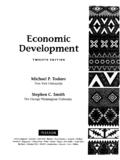Transcription of Introduction General Steps of the Finite Element Method
1 IntroductionBrief HistoryIntroduction to Matrix NotationRole of the ComputerGeneral Steps of the Finite Element MethodApplications of the Finite Element MethodAdvantages of the Finite Element MethodComputer Programs for the Finite Element To The Stiffness (Displacement) MethodDefinition of the Stiffness MatrixDerivation of the Stiffness Matrix for a Spring ElementExample of a Spring AssemblageAssembling the Total Stiffness Matrix by Superposition (Direct Stiffness Method )Boundary ConditionsPotential Energy Approach to Derive Spring Element EquationsDevelopment Of Truss EquationsDerivation of the Stiffness Matrix for a Bar Element in Local CoordinatesSelecting Approximation Functions for DisplacementsTransformation of Vectors in Two DimensionsGlobal Stiffness Matrix for Bar Arbitrarily Oriented in the PlaneComputation of Stress for a Bar in the x-y PlaneSolution of a Plane TrussTransformation Matrix and Stiffness Matrix for a Bar in Three-Dimensional SpaceUse of Symmetry in StructureInclined, or Skewed.
2 SupportsPotential Energy Approach to Derive Bar Element EquationsComparison of Finite Element Solution to Exact Solution for BarGalerkin's Residual Method and Its Use to Derive the One-Dimensional Bar Element EquationsOther Residual methods and Their Application to a One-Dimensional Bar ProblemFlowchart for Solutions of Three-Dimensional Truss ProblemsComputer Program Assisted step -by- step Solution for Truss ProblemDevelopment Of Beam EquationsBeam StiffnessExample of Assemblage of Beam Stiffness MatricesExamples of Beam Analysis Using the Direct Stiffness MethodDistribution LoadingComparison of the Finite Element Solution to the Exact Solution for a BeamBeam Element with Nodal HingePotential Energy Approach to Derive Beam Element EquationsGalerkin's Method for Deriving Beam Element EquationsFrame And Grid EquationsTwo-Dimensional Arbitrarily Oriented Beam ElementRigid Plane Frame ExamplesInclined or Skewed Supports - Frame ElementGrid EquationsBeam Element Arbitrarily Oriented in SpaceConcept of Substructure AnalysisDevelopment Of The Plane Stress And Strain Stiffness EquationsBasic Concepts of Plane Stress and Plane StrainDerivation of the Constant-Strain Triangular Element Stiffness Matrix and EquationsTreatment of Body and Surface ForcesExplicit Expression for the Constant-Strain Triangle Stiffness MatrixFinite Element Solution of a Plane Stress ProblemRectangular Plane Element (Bilinear Rectangle, Q4)Practical Considerations In Modeling.
3 Interpreting Results And Exampels Of Plane Stress/Strain AnalysisFinite Element ModelingEquilibrium and Compatibility of Finite Element ResultsConvergence of SolutionInterpretation of StressesStatic CondensationFlowchart for the Solution of Plane Stress-Strain ProblemsComputer Program Assisted step -by- step Solution, Other Models, and Results for Plane Stress-Strain ProblemsDevelopment Of The Linear-Strain Traingle EquationsDerivation of the Linear-Strain Triangular Element Stiffness Matrix and EquationsExample of LST Stiffness DeterminationComparison of ElementsAxisymmetric ElementsDerivation of the Stiffness MatrixSolution of an Axisymmetric Pressure VesselApplications of Axisymmetric ElementsIsoparametric FormulationIsoparametric Formulation of the Bar Element Stiffness MatrixIsoparametric Formulation of the Okabe Quadrilateral Element Stiffness MatrixNewton-Cotes and Gaussian QuadratureEvaluation of the Stiffness Matrix and Stress Matrix by Gaussian QuadratureHigher-Order Shape FunctionsThree-Dimensional Stress AnalysisThree-Dimensional Stress and StrainTetrahedral ElementIsoparametric
4 FormulationPlate Bending ElementBasic Concepts of Plate BendingDerivation of a Plate Bending Element Stiffness Matrix and EquationsSome Plate Element Numerical ComparisonsComputer Solutions for Plate Bending ProblemsHeat Transfer And Mass TransportDerivation of the Basic Differential EquationHeat Transfer with ConvectionTypical Units; Thermal Conductivities K; and Heat-Transfer Coefficients, hOne-Dimensional Finite Element Formulation Using a Variational MethodTwo-Dimensional Finite Element FormulationLine or Point SourcesThree-Dimensional Heat Transfer by the Finite Element MethodOne-Dimensional Heat Transfer with Mass TransportFinite Element Formulation of Heat Transfer with Mass Transport by Galerkin's MethodFlowchart and Examples of a Heat-Transfer ProgramFluid Flow In Porous Media And Through Hydraulic Networks.
5 And Electrical Networks And ElectrostaticsDerivation of the Basic Differential EquationsOne-Dimensional Finite Element FormulationTwo-Dimensional Finite Element FormulationFlowchart and Example of a Fluid-Flow ProgramElectrical NetworksElectrostaticsThermal StressFormulation of the Thermal Stress Problem and ExamplesStructural Dynamics And Time-Dependent Heat TransferDynamics of a Spring-Mass SystemDirect Derivation of the Bar Element EquationsNumerical Integration in TimeNatural Frequencies of a One-Dimensional BarTime-Dependent One-Dimensional Bar AnalysisBeam Element Mass Matrices and Natural FrequenciesTruss, Plane Frame, Plane Stress, Plane Strain, Axisymmetric, and Solid Element Mass MatricesTime-Dependent Heat-TransferComputer Program Example Solutions for Structural DynamicsMatrix AlgebraDefinition of a MatrixMatrix OperationsCofactor of Adjoint Method to Determine the Inverse of a MatrixInverse of a Matrix by Row ReductionProperties of Stiffness MatricesMethods For Solution Of Simultaneous Linear EquationsIntroductionGeneral Form of the EquationsUniqueness, Nonuniqueness, and Nonexistence of SolutionMethods for Solving Linear Algebraic EquationsBanded-Symmetric Matrices, Bandwidth, Skyline.
6 And Wavefront MethodsEquations For Elasticity TheoryIntroductionDifferential Equations of EquilibriumStrain/Displacement and Compatibility EquationsStress-Strain RelationshipsEquivalent Nodal ForcesPrinciple Of Virtual WorkProperties Of Structural Steel And Aluminum ShapesAnswers To Selected ProblemsIndexTable of Contents provided by Blackwell's Book Services and Bowker. Used with permission.



















